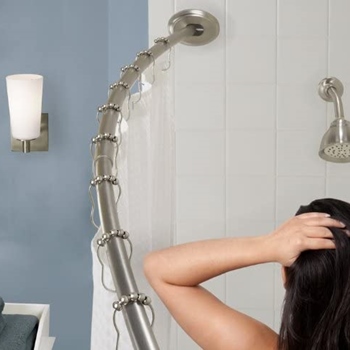So, you installed a new shower and now you want to treat it to a nice shower curtain. You picked the design and the approximate size, but a question remains – “will it be enough to cover the whole shower opening?”. Getting a shower curtain of proper size is not important only for the looks, but for other reasons as well. Water damage, condensation, leakage – everything can be prevented if you have adequate protection from shower splash, i.e. a shower curtain that fits your shower dimensions.
I am aware that people rarely talk about smaller things like shower curtain size, but I think it is high time we touched upon this subject. You’d be amazed by how much money you can actually save by installing a shower curtain that fits properly, protecting the rest of your bathroom from water damage. Let’s dig into it!
Shower Curtain – The Default Size
 The market of today certainly has a lot to offer in terms of shower curtain designs, but when it comes to sizes, the pool is not as rich. The standard shower curtain size is somewhere around 72 x 72 inches, with a 2 to 4 inches up or down. This may sound like a lot, but if you have a shower that deviates from standard sizes (which is most likely the case), you will have to adjust the curtain somehow.
The market of today certainly has a lot to offer in terms of shower curtain designs, but when it comes to sizes, the pool is not as rich. The standard shower curtain size is somewhere around 72 x 72 inches, with a 2 to 4 inches up or down. This may sound like a lot, but if you have a shower that deviates from standard sizes (which is most likely the case), you will have to adjust the curtain somehow.
Even though the design does not matter in any way except aesthetics, don’t get disappointed if you can’t find the right size for the one you wanted. So, to save yourself from future letdowns, I think it is important to learn how to measure things properly.
Measure the Width of the Shower Curtain First
Start the measuring process by measuring the width first. So, take the measuring tape and see how wide the whole shower cabin (aka shower chamber) actually is. In my opinion, you should be generous and measure the outer edges of the cabin, no matter how thick they are.
After you get the width of the shower, add another 12 to 15 inches to the number. This extra space will account for all the folding parts. It will also allow you to cover the whole width of the shower cabin and additional material to help with actually using the shower curtain. If the width of the curtain matches the exact width of the shower, you are bound to make the rest of the bathroom wet.
On the other hand, getting a shower curtain that is too wide is not good either. A drape with all that extra material will stick together once it gets wet. When that happens, you are essentially dealing with a narrower drape due to shrinkage.
Shower Curtain Length is Also Important
At first thought, it might seem like a good idea to get a shower curtain that goes all the way to the floor. But experience shows otherwise. Because we are talking about showering with hot water, there will be a lot of humidity and mildew included – not to mention the potential mold that will appear if the moisture is not regulated.
So, what you need to do is – measure the height from the floor to the shower curtain rod. Take this measurement and subtract about 3 to 5 inches to account for the ventilation under the curtain. This will ensure that there is no extra moisture buildup. There is no need to completely shut off the shower cabin from the rest of the bathroom using the shower curtain. Some ventilation space is always a good idea.
Shower Curtain Rod – Is it Important?
The placement of the shower rod is equally important as the shower curtain width and length, and people still forget to factor it into the equation. Some people even install the shower curtain rod as high as possible, sometimes even touching the ceiling. But this is not the way to go, again, for ventilation reasons.
Instead, you should think proactively and stop the mold from appearing by accounting for some free air over (and under) the rod. So, if we go with the standard shower curtain length of 72 to 75 inches, and we factor in 3 to 5 inches for the bottom of the curtain, the rod should be at about 75 to 80 inches from the floor.
Tips and Tricks
 Besides knowing the width and height of the shower curtain, including the shower curtain rod position, there are some things people often forget to talk about.
Besides knowing the width and height of the shower curtain, including the shower curtain rod position, there are some things people often forget to talk about.
- You need to wash your shower curtain every one in a while. Use the setting for gentle washing on your machine. A mix of detergent and a few drops of white vinegar should do the trick. Once the machine is done washing, install the shower curtain and spread it as wide as you can, leaving it to dry out. Opening a window or turning the ventilation on should be a must.
- If your shower curtain rod has rings (instead of the curtain going directly around it), don’t forget to factor the ring width into the equation. This can make a difference, sometimes even by a few inches.
- For the shower curtain to do its job properly, you need all the holes to have a ring through them. A missing ring will make the curtain fold awkwardly, it will make it go lower than the rest, ultimately defeating the purpose. Luckily, a lot of shower curtain manufacturers provide extra rings for the shower curtain rod. Store them someplace safe, and pull them out once a ring breaks or gets damaged.
Wrap Up
Who would have thought that you can protect your bathroom by measuring stuff? A little patience and a measuring tape are your allies here. Not only will you protect your bathroom from all sorts of irreversible damage, but your bathroom will also look nice and tidy if you get a shower curtain that fits perfectly. Prevention is key here, and by installing a curtain that matches the dimensions of your shower, you get to prevent water damage and protect your wallet from running dry as well.
Now go and find the shower curtain that you won’t get tired of watching every day. Just remember to measure your shower stall/cabin first. A bathroom is a place we need to feel relaxed in, so every bit of improvement counts, even if we are talking about shower curtain sizes. Stay comfy and have fun in your future bathroom-improving endeavors!
Bonus guide: best shower curtain liners